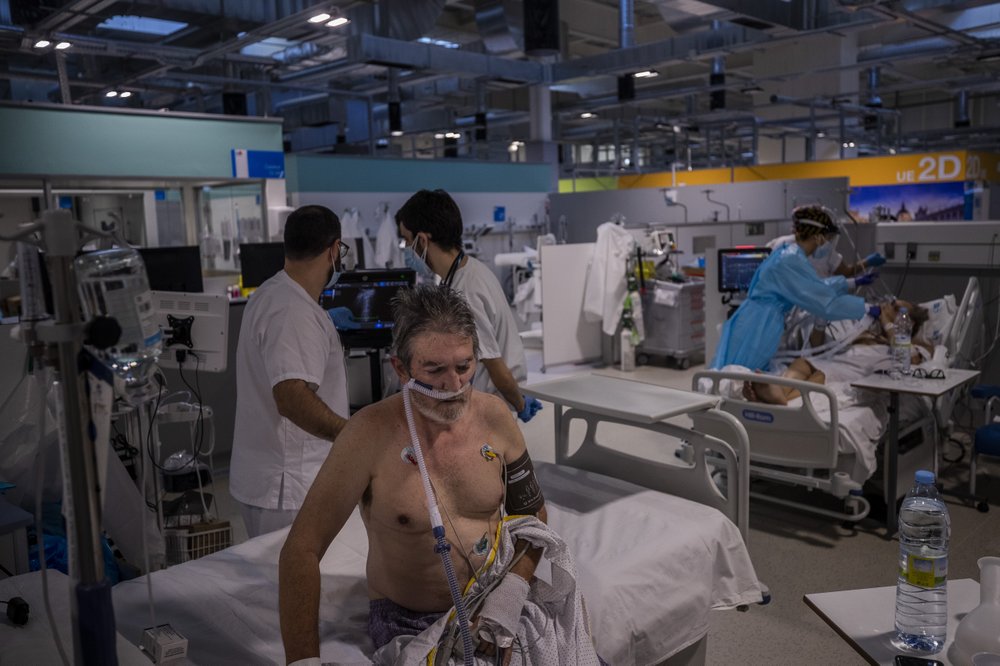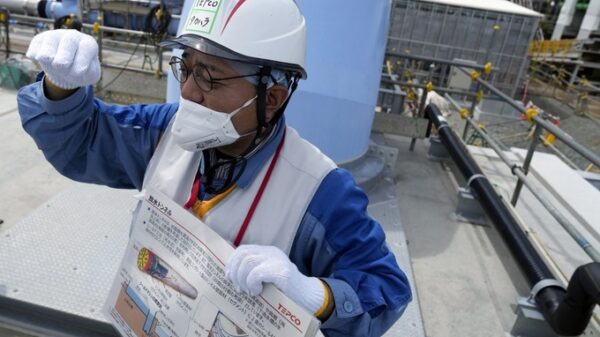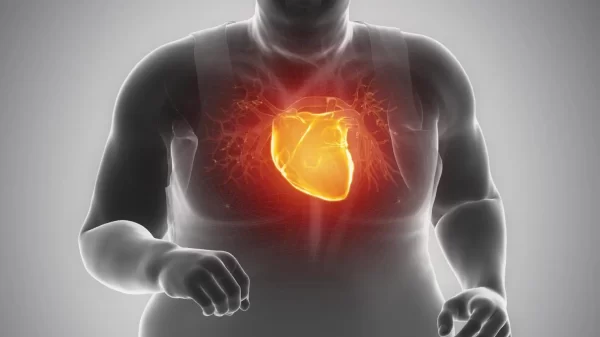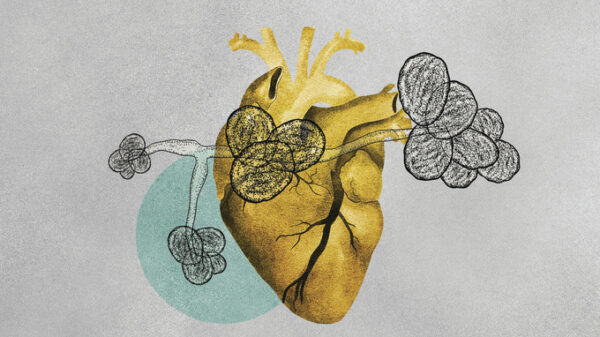Doctors use an ultrasound scan to examine the lungs of a COVID-19 patient at the new Nurse Isabel Zendal Hospital in Madrid Madrid, Spain, Monday, Jan. 18, 2021. As the coronavirus curve of contagion turned increasingly vertical after Christmas and New Year’s, the Zendal has been busy. On Monday, 392 virus patients were being treated, more than in any other hospital in the Madrid region. (AP Photo/Bernat Armangue)
MADRID (AP) — As soon as the lifeless body is silently pushed away on a stretcher, a cleaning battalion moves into the intensive care box. In a matter of minutes, the bed where the 72-year-old woman fought for over two weeks for another breath gets rubbed clean, the walls of glass isolating it disinfected with a squeegee.
There is little time to reflect on what has just happened, as death gives way to the possibility of saving another life.
“Our biggest source of joy is obviously emptying a bed, but because somebody is discharged and not because they have passed away,” said Ignacio Pujol, the head of this Madrid ICU. “That’s a little space there for somebody else to get another chance.”
As a surge of infections is once again putting Spain’s public health system against the ropes, the Nurse Isabel Zendal Hospital that employs Pujol, a project seen by many as an extravagant vanity enterprise, is getting a fresh opportunity to prove its usefulness.
Named after the 19th-century Spanish nurse who took smallpox vaccination across the Atlantic Ocean, the facility was built in 100 days at a cost of 130 million euros ($157 million), more than twice the original budget. It boasts three pavilions and support buildings over an area the size of 10 soccer fields, looking somewhere between a small airport terminal and an industrial warehouse, with ventilation air ducts, medical beds and state-of-the-art equipment. The original project was for 1,000 beds, of which roughly half have been installed so far.
The Zendal opened to a roar of competing fanfare and criticism on Dec. 1, just as Spain seemed to dampen a post-summer surge of coronavirus infections. By mid-December, it had only received a handful of patients.
But Spain on Monday recorded over 84,000 new COVID-19 infections, the highest increase over a single weekend since the pandemic began. The country’s overall tally is heading to 2.5 million cases with 53,000 confirmed virus deaths, although excess mortality statistics add over 30,000 deaths to that.
As the curve of contagion steepened after Christmas and New Year’s, the Zendal has gotten busy. On Monday, 392 patients were being treated, more than in any other hospital in the region of 6.6 million.
Spain’s surge follows similar infection increases in other European countries, most notably in the U.K. following the discovery of a new virus variant that experts say is more infectious. The London Nightingale, one of the temporary hospitals across Britain designed to ease pressure on the country’s overwhelmed health care system, has also reopened for patients and as a vaccination center.
Spain’s top health officials insist they have found no evidence that new variants wreaking havoc elsewhere are contributing in any way to its own rocketing infections. Some experts dispute that, claiming the country’s limited ability to sequence coronavirus cases is distorting reality and that a new stay-at-home order is necessary.
On the ground, increasing hospitalizations for the virus already surpass the peak of the second resurgence. Nearly one out of every five hospital beds has a patient with COVID-19. The new illness is also taking up one-third of the country’s ICU capacity and non-urgent surgeries are already being called off.
Joined by some medical experts, left-wing politicians and workers’ unions accuse Madrid’s conservative government of spending on vote-attracting hardware instead of reinforcing a public health system they have underfunded for years. Investing in contact tracing and primary care previously, they say, could have averted the need for a Zendal altogether.
“Rather than the success they boast, the filling up of this makeshift hospital represents a tremendous failure of those at the helm of the pandemic’s response, and also a failure of all of us as a society that could have done better,” said Ángela Hernández, a spokeswoman for Madrid’s main medical workers’ union, AMYTS.
The last straw for the unions, she said, has been the regional government laying off medical staff who refuse to abandon their positions in regular hospitals when they are reassigned to the Zendal.
“The project has been nonsense from beginning to end,” Hernández said. “A few beds without adequate personnel don’t make a hospital.”
Fernando Prados, Zendal’s manager, says he doesn’t mind the debate but the 750 patients treated over the last month and a half have already taken significant pressure off other hospitals.
“We have already contributed in one way or another,” Prados said. “We know that we will continue to have COVID patients and once the pandemic is over this infrastructure will be here for any other emergency.”
Past automatic glass doors, patients recover in modules of 8 beds, leaving little space for privacy but providing better monitoring of possible complications in their recovery, said Verónica Real, whose challenge as the head nurse has been to organize staff teams drawn from other hospitals.
“Some of the sanitary workers arrive with a degree of anger for all the noise out there about our hospital,” Real said. “But once here, the attitude completely changes.”
The Zendal’s managers say a modern ventilation system renews the entire facility’s air every 5 minutes, which contributes to a safer work environment. But they are most proud of the expansion of the intermediate respiratory care unit, where patients receive varying types of assisted respiration to overcome lung inflammation.
The unit’s chief, Pedro Landete, says by admitting potentially worsening patients in one of its 50 highly-equipped beds, they are reducing the number of people who later require the more demanding intensive care.
José Andrés Armada arrived with mild symptoms at the facility after all his family was infected despite what he said was a very careful approach to the pandemic. But the 63-year-old’s health quickly deteriorated and last week he was on the brink of being intubated in one of the Zendal’s dozen ICU boxes.
“I know that the economy is something to safeguard, but health is more important. We should be in lockdown by now. You can’t have bars and other places open,” the former entrepreneur said.
“I never imagined it could attack you in such a way.”
AP reporter Jill Lawless in London contributed to this report.
Copyright 2020 Associated Press. All rights reserved.





























